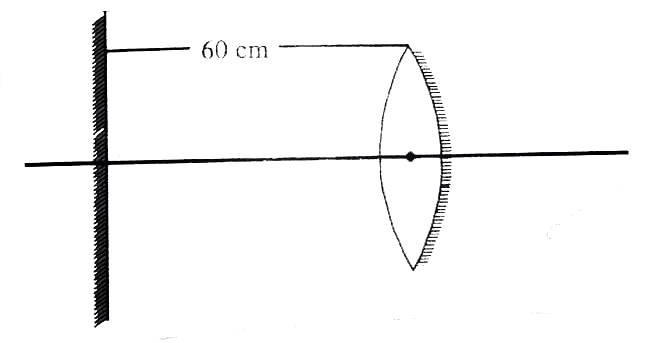Two thin similar watch glass pieces are joimed together,front to front ,woth near convex portion silvered and the combination of glass pieces is placed at a distanc ea=60cm from a screen.A small object is placed normal to the optical axis of the combination such that its two waterμ=4/3,calcuated the distance through,which the object must eb displayed so that a sharp image is again formed on the screen.
The correct Answer is:15cmtowards the combination

First It is concave mirror
m=h2h1=−vu⇒−2=−vu
v=2u⇒−60=2u⇒u=−30
Applying mirror formula
1v+1u=1f⇒1−60+1−30=1f
1f=−1−260⇒f=−20cm⇒R=−40cm
Pm=−100f⇒Pm=5D
When the liquid in filled it will become a combination of convex lens and concave mirror Peq=2Pl+Pm
1fl=(.aμl−1)(1R1−1R2)⇒1fl=2(.aμl−1)R
1fl=2(4/3−1)40⇒1fl=160⇒fl=60cm⇒Pl=53D Peq=2Pl+Pm⇒Peq=2×53+5⇒Peq=253D
feq=100−Peq⇒feq=1000−25/3⇒feq=−12cm
to form image again on screen
1−60+1u2=1−12⇒1u2=160−112⇒1u2=+1−560
u2=−15cm
Shift=(30−15)
Shift =15towards the combination.
Similar Questions
Two thin similar convex glass are joined together front to front, with its rear portion silvered such that a sharp image is formed 0.2m for an object at infinity. When the air between the glass pieces is replaced by water (μ=43), find the position of image.
View SolutionA convex lens focuses an object 40cm from it on a screen placed 10cm away from it. A glass plate (μ=1.5) and of thickness 3cm is inserted between the lens and the screen. Where should the object be placed so that its image is again focused on the screen ?
View Solution
Knowledge Check
Two thin lenses of powers 2D and 3D are placed in contact. An object is placed at a distance of 30 cm from the combination The distance in cm of the image from the combination is
A30B40C50D60A thin converging lens of focal length f = 25 cm forms the image of an object on a screen placed at a distance of 75 cm from the lens. Now the screen in moved closer to the lens by a distance of 25 cm. The distance through which the object has to be shifted so that its image on the screen is sharp again is
A37.5 cmB16.25 cmC12.5 cmD13.5 cmA thin biconvex lens of focal length f=25cm forms a real image of a real object an a screen. The object is separated by 5cm from the lens. The screen is drawn closer to the lens by a distance 18cm. Through what distance (approximately) must the object be shifted so that its image is again formed on the screen ?
A0.5mm toward leftB0.25mm toward leftC2.5mm toward leftD1.4mm toward left
Two coaxial thin lenses are placed in contact with each other and a small object is placed at a distance of 20cm from the combination of lenses. The focal length of each lens is 30 cm. What will be the distance between the object and the image when both the lenses are (i) convex (ii) concave
View SolutionAn object is placed at a certain distance from a screen. A convex lens of focal length 20cm is placed between the screen and the object. A real image is formed on the screen for two positions of the lens, which differ by a distance of 10cm. What is the distance of the object from the screen ?
View SolutionAn object 1 m tall is placed on the principal axis of a convex lens and its 40 cm tall image is formed on the screen placed at a distance of 70 cm from the object. What is the focal length of the lens ?
View SolutionTwo thin lenses of powers 2D and 4D are placed in close contact. An object is placed at a distance of 50 cm from the combination. What is the distance of the image from the combined lens ?
View SolutionA slab of glass of refractive index 1.5 and thickness 3cm is placed with the faces perpendicular to the principle axis of a concave mirror. If the radius of curvature of the mirror is 10cm, the distance at which an object must be placed from the mirror so that the image coincides with the object is
View Solution
